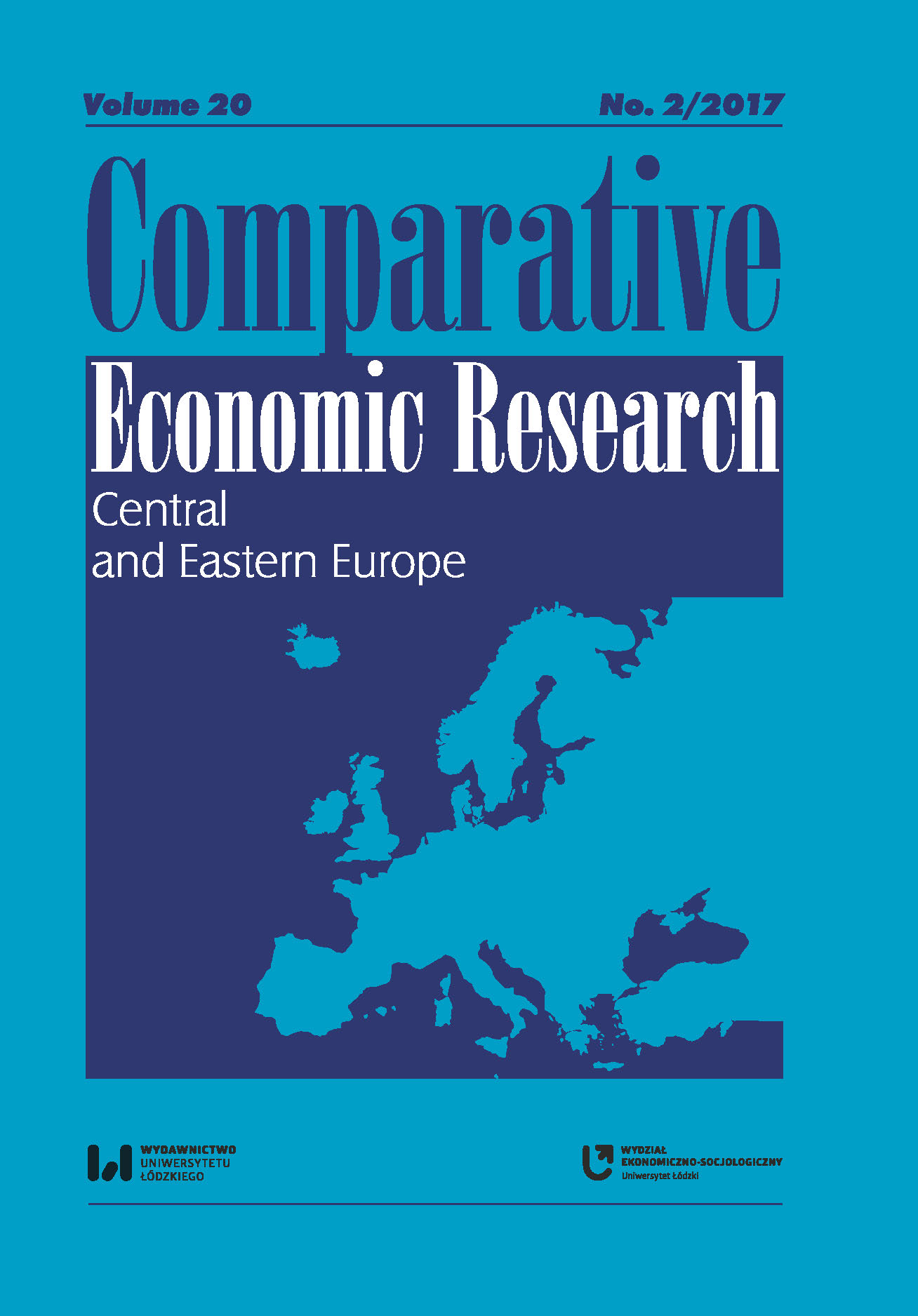Prognozowanie stop bezrobocia – porównanie modeli SARIMA i modeli nieobserwowanych komponentów dla wybranych krajów Europy Środkowej i Wschodniej
DOI:
https://doi.org/10.1515/cer-2017-0014Słowa kluczowe:
stopa bezrobocia, modele nieobserwowanych komponentów, modele SARIMA, trafność prognozAbstrakt
W artykule porównano prognozy wskaźników stóp bezrobocia w ośmiu krajach Europy Środkowej i Wschodniej. Zastosowano modele nieobserwowanych komponentów i sezonowe modele ARIMA w przesuwanym oknie i postawiono prognozy krótkoterminowe weryfikowane na podstawie trafności prognozy spoza próby. Wykazano, że w przypadku trzech krajów stopa bezrobocia charakteryzuje się bezwarunkową asymetrią. Generalnie w przypadku stosowanych metod, dla połowy badanych szeregów nie znaleziono statystycznie istotnej różnicy w dokładności stawianych prognoz. W pozostałych przypadkach odpowiednio dobrany sezonowy model ARIMA pozwalał na postawienie lepszych prognoz. Ponadto wykazano, że trafność prognoz pogarsza się w okresach gwałtownych wzrostów i spadków stóp bezrobocia, a poprawia się w okresach nieznacznych zmian wielkości tego wskaźnika.
Pobrania
Bibliografia
Altissimo F., Violante G.L. (2001), The Non-Linear Dynamics of Output and Unemployment in the U.S., ‘Journal of Applied Econometrics’ 16: 461–486.
Google Scholar
Belaire-Franch J., Peiró A. (2015), Asymmetry in the relationship between unemployment and the business cycle, ‘Empirical Economics’ 48, 2: 683–697.
Google Scholar
Będowska-Sójka B. (2015), Unemployment Rate Forecasts. The Evidence from the Baltic States, ‘Eastern European Economics’ 53: 57–67.
Google Scholar
Caner M., Hansen B.E (2001), Threshold Autoregression with a Unit Root, ‘Econometrica’ 69: 1555–1596.
Google Scholar
Diebold F.X., Mariano R.S (1995), Comparing predictive accuracy, ‘Journal of Business and Economic Statistics’ 13: 253–263.
Google Scholar
Doornik J.A., Hendry D.F. (2005), Empirical Econometric Modelling. PcGiveTM11, Timberlake Consultants, London.
Google Scholar
Hamilton J.D. (2005), What’s real about the business cycle?, Federal Reserve Bank St. Louis Review 2005: 425–452.
Google Scholar
Harvey A.C. (1989), Forecasting Structural Time Series Models and the Kalman Filter, Cambridge: Cambridge University Press.
Google Scholar
Harvey A.C. (2006), Forecasting with Unobserved Component Time Series Models, [in:] Elliott G., Granger C.W.J., Timmermann A., Handbook of Economic Forecasting, vol. I, North-Holland, Elsevier.
Google Scholar
Harvey D., Leybourne S.J., Newbold P. (1997), Testing the Equality of Prediction Mean Squared Errors, ‘International Journal of Forecasting’, vol. 13: 281–291.
Google Scholar
Hayfield T., Racine J.S. (2008), Nonparametric Econometrics: The np Package, ‘Journal of Statistical Software’ 27(5), URL http://www.jstatsoft.org/v27/i05/.
Google Scholar
Hyndman R.J., Khandakar Y. (2008), Automatic time series forecasting: the forecast package for R, ‘Journal of Statistical Software’ 26(3): 1–22.
Google Scholar
Koop G.S., Potter M. (1999), Dynamic Asymmetries in U.S. Unemployment, ‘Journal of Business and Economic Statistics’ 17 (3): 298–312.
Google Scholar
Koopman S.J., Harvey A.C., Doornik J.A., Shephard N. (2006), Structural Time Series Analyser and Modeller and Predictor STAMP 7, Timberlake Consultants, London.
Google Scholar
Marcellino M. (2002), Instability and non-linearity in the EMU, Discussion Paper No. 3312, Centre for Economic Policy Research.
Google Scholar
Maasoumi E., Racine J.S. (2009), A robust entropy-based test of asymmetry for discrete and continuous processes, ‘Econometric Reviews’, 28: 246–261.
Google Scholar
Milas C., Rothman P. (2005), Multivariate STAR Unemployment Rate Forecasts, ‘Econometrics’ 0502010, EconWPA.
Google Scholar
Montgomery A.L., Zarnowitz V., Tsay R.S., Tiao G.C. (1998), Forecasting the U.S. Unemployment Rate, ‘Journal of the American Statistical Association’ 93, no. 442: 478–493.
Google Scholar
Proietti T. (2003), Forecasting the US unemployment rate, ‘Computational Statistics and Data Analysis’ 42: 451–476.
Google Scholar
Racine J.S., Maasoumi E. (2007), A versatile and robust metric entropy test of time-reversibility, and other hypotheses, ‘Journal of Economics’ 138: 547–567.
Google Scholar
Skalin J., Teräsvirta T. (2002), Modeling asymmetries and moving equilibria in unemployment rates, Macroeconomic Dynamics 6: 202–241.
Google Scholar
Snedecor G.W., Cochran W.G. (1989), Statistical Methods, Eighth Edition, Iowa State University Press.
Google Scholar
Stock J.H., Watson M.W. (1999), Business cycle fluctuations in us macroeconomic time series, in: Taylor, J. B., M., Woodford (ed.) Handbook of Macroeconomics, volume I: 3–64, Elsevier.
Google Scholar
Teräsvirta T., van Dijk D., Medeiros M.C. (2005), Smooth transition autoregressions, neural networks, and linear models in forecasting macroeconomic time series: A reexamination, ‘International Journal of Forecasting’ 21: 755–774.
Google Scholar
Pobrania
Opublikowane
Jak cytować
Numer
Dział
Licencja

Utwór dostępny jest na licencji Creative Commons Uznanie autorstwa – Użycie niekomercyjne – Bez utworów zależnych 4.0 Międzynarodowe.











